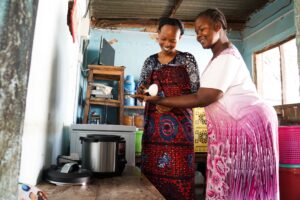By Eleanor Wagner, Marketing Communications Executive, Energy Saving Trust, Co-Secretariat of the Efficiency for Access Coalition
This interview was conducted with Amita Bhakta for Efficiency for Access, a global coalition to accelerate clean energy access through high-performing appliances, and originally appeared here on their website.

Amita Bhakta started her education in geography, completing a BA (Hons) in Human Geography and an MRes Geography at the University of Leicester, UK. She then joined the water, sanitation and hygiene (WASH) sector where she became the first Indian woman with Cerebral Palsy to complete a PhD at the Water Engineering and Development Centre (WEDC) in the School of Architecture, Building and Civil Engineering at Loughborough University, UK.
She is now an interdisciplinary researcher, focusing on access to modern energy, intersectionality, and the needs of people with disabilities in low and middle-income countries.
In this interview, Amita talks about inequalities in the energy access sector and opportunities and recommendations for improving equality whilst working towards achieving the Sustainable Development Goals.
Where do you see the biggest inequalities when working towards the Sustainable Development Goals (SDGs)?
I think the biggest inequalities come about when we do not pay enough attention to less visible, cross-cutting ‘hidden’ issues rather than hidden groups. When we’re thinking about access to energy for all, we often miss the need for energy at an individual level, such as access to clean energy for boiling water to bathe. For example, people in certain age groups may wish to heat their water to bathe to aid their wellbeing, but as bathing isn’t discussed, the SDGs miss large inequalities in more mundane aspects of life. My previous PhD research on the water, sanitation and hygiene needs of perimenopausal women identified that the menopause is largely missed as an issue for the SDGs to address
Where do you see the main opportunities for improving equality while working towards the SDGs?
Improving equality through the SDGs has to be about the people. I see opportunities not just in the delivery of outcomes, but in the methods and creativity we use in engaging with people, particularly in the global South. Our work towards meeting the SDGs and providing clean energy should provide a chance for us to learn how to engage with and deliver upon the needs of more marginalised groups such as women, people with disabilities, and those whose voices are less heard. We can learn so much from others who are working with various groups in the global South about a range of practical techniques.
What has been the biggest challenge of your career so far?
One of the biggest challenges of my career has been trying to raise awareness of the need to better recognise intersectionality. It is something I champion through all of my work because we need to recognise that there are different aspects of people’s identities that shape their life experience. I think there is a sense of caution among colleagues towards using the word to describe what is simply acknowledging the ways in which an individual can be excluded due to different factors such as gender, disability and caste for example coming together. It is not a scary word and we should be talking about it more!
How can energy access programmes and people in the sector be more inclusive in their approach?
Recognise the different dimensions of individuals’ lives which may affect their energy access. It may seem easier to go for obvious markers of identity, such as gender, but if you widen your scope and talk about the things people tend not to talk about, then we might begin to understand what ‘energy for all’ really means.
How can we address the needs of people with disabilities?
Including people with disabilities in energy access programmes requires us to put their needs at the centre of programme design first and foremost. Programmes are likely to be most effective if they are accessible to people with disabilities. Good measures to increase inclusivity in programmes include hosting activities that involve hiring people with disabilities in accessible locations, hiring sign-language interpreters who speak local languages, ensuring that programme materials are available in different formats to cater for different impairments, and enabling carers to join activities and encouraging a range of individuals with diverse disabilities to participate.
